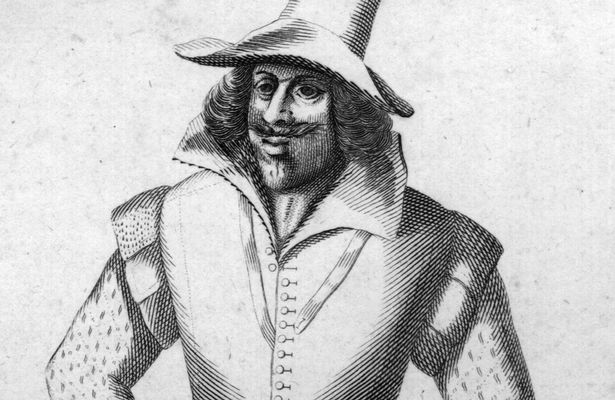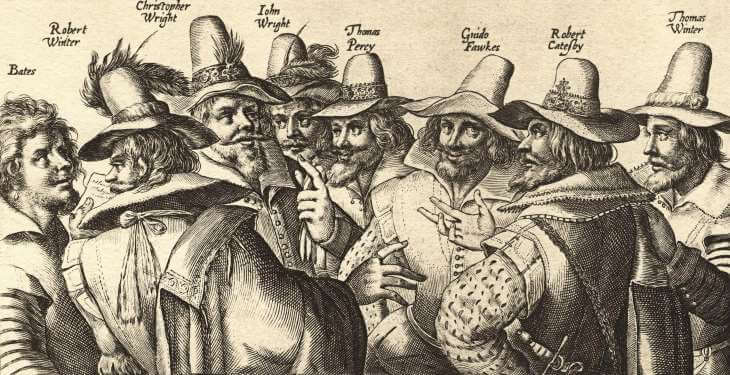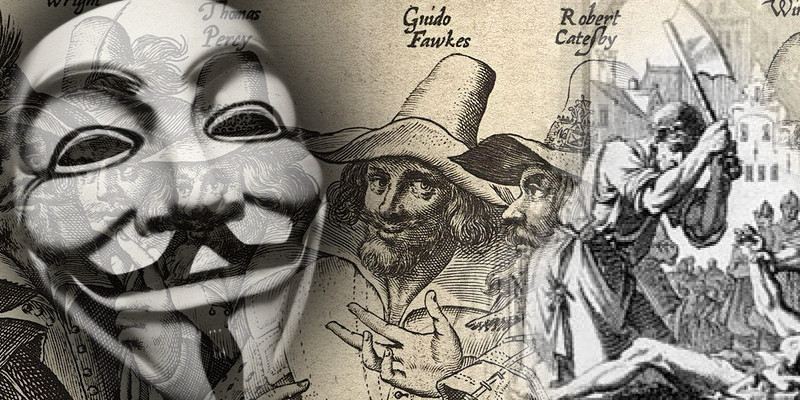By Penny Theodorakopoulou,
“Remember, remember, the Fifth of November
Gunpowder Treason and plot
I see no reason
Why Gunpowder treason
Should ever be forgot.”
Those are the infamous words that the classic movie V for Vendetta (2005) starts with. And let’s be honest, most of us would not have the slightest idea of who Guy Fawkes is, what the Gunpowder Plot is, and, most importantly, why the 5th of November is such a significant day, that it became a nursery rhyme and is internationally known as the “Guy Fawkes Day” (also known as the “Guy Fawkes Night”, “Fireworks Night”, and “Bonfire Night”). However, in order to fully understand the motivations behind the Gunpowder Plot, we first need to explain the conflicts between English Catholics and Protestants at that time.
The Catholicism-Protestantism rivalry
Catholicism in Britain was intensely curbed beneath Queen Elizabeth I, especially after the Pope expelled her in 1570. Amid her rule, handfuls of clerics were put to passing, and Catholics may not indeed lawfully celebrate Mass or be hitched concurring to their claim customs. As a result, numerous Catholics had tall trusts when King James I took the position of royalty upon Elizabeth’s passing in 1603. James’s spouse, Anne, is accepted to have already changed over to Catholicism, and his mother, Mary Ruler of Scots, was Elizabeth’s Catholic archrival earlier to being executed. There were indeed rumors, propelled by his political suggestions to the Pope, that James himself would end up Catholic.
Before long, it was clear, in any case, that James did not back devout resilience for Catholics. In 1604, he freely condemned Catholicism as a superstition, requested all Catholic clerics to take off Britain, and communicated concern that the number of Catholics was expanding. He too proceeded to a great extent with the oppressive approaches of his forerunner, such as fines for those denying to go to Protestant administrations.
English Catholics had organized a few fizzled schemes against Elizabeth, and these proceeded beneath James. In 1603 a number of clerics and laymen brought forth the so-called Bye Plot to capture James, as it were to be turned in by individual Catholics. Another related trick that year, known as the Most Plot, looked for the murder of James and introduce his cousin to the position of royalty. At that point, in May 1604, a modest bunch of Catholic dissident —Guy Fawkes, Robert Catesby, Tom Wintour, Jack Wright, and Thomas Percy— met at the Duck and Drake motel in London, where Catesby proposed an arrangement to blow up the Houses of Parliament with gunpowder. A short time later, all five men purportedly swore a pledge an oath of secrecy upon a supplication book.
Who is Guy Fawkes?
We do not know much about his life or how he looked exactly (apart from a variety of caricatures), but from the limited intel we have in regard to him, Guy Fawkes was born during the reign of Queen Elizabeth I, (13 April 1570) in York, Britain. Being a member of the Yorkshire family, Fawkes converted to Catholicism and, in 1593, he set out to Europe’s mainland. Enlisting in the Spanish Army in the Netherlands, he battled for Catholic Spain within the Eighty Years’ War against Protestant Dutch reformers in the Low Countries.

After the war was over, he met Thomas Wintour, with whom he returned to Britain. Wintour presented him to Robert Catesby, who wanted to assassinate King James I and re-establish a Catholic monarch to the position of royalty. Fawkes was informed in regard to Catesby’s plans, hence he returned to Britain with Wintour. The plotters rented an undercroft underneath the House of Rulers; Fawkes was put in charge of the gunpowder that they had stockpiled there. The authorities were provoked by an anonymous letter to look at Westminster Palace amid the early hours of November 5th, where they found Fawkes guarding the 36 barrels containing explosives. On January 27th, after being tormented relentlessly, confessed to being a member of the Gunpowder Plot and his purpose of blowing up the House of Lords. Lastly, on January 31st, his execution took place. Being convicted for high treason, his criminal penalty was to be hanged, drawn, and quartered. However, Fawkes fell from the scaffold where he would be executed and thus breaking his neck, “liberating” him from the agonizing death he would soon suffer.
The Gunpowder Plot and treason
Given the information above, we can conclude that Catesby was considered the instigator of the Gunpowder Plot — also known as the “Jesuit Treason”. And, as mentioned above, the Gunpowder Plot’s motive was to assassinate King James I, as well as the members of Westminster Palace (Houses of Parliament). In addition to that, Catesby also looked to re-establish the Catholic monarchy from the Church of England after decades of bigotry against Catholics.
The participants on the Gunpowder Plot were: Robert Catesby, John Wright, Christopher Wright, Robert Wintour, Thomas Wintour, Thomas Percy, Guy Fawkes, Robert Keyes, Thomas Bates, John Grant, Ambrose Rookwood, Sir Everard Digby, and Francis Tresham. The plan was simple: on November 5th, 1605, when the State Opening of Parliament would take place, barrels would be put underneath the building and someone would be responsible for lighting the barrels, which contained gunpowder, on fire — and the one who was responsible for that task was Guy Fawkes since he was familiar with gunpowder due to his military past in the Spanish Netherlands.
However, since we know a posteriori that the Gunpowder Plot was a failure, the authorities receive an anonymous letter on October 26th, the content of which included that someone during the early hours of November 5th would be underneath Westminster Palace in order to blow it up. The evening before November 5th, the authorities searched the House of Lords and found Fawkes guarding the 36 barrels of gunpowder, which were enough to blow up the entire building, arresting him the moment they saw him. In the end, every member of the Gunpowder Plot was arrested and executed for high treason.

Guy Fawkes Day
Due to the fact that King James I survived the attempted assassination, in 1606, a year after the Gunpowder Plot’s failure, bonfires were lit around the city of London — and a few months later, this act became a British tradition in order to “celebrate” the failure of the plot as an act of national thanksgiving.
Straw models of Fawkes are hurled on the campfire, as are — later, in a few places — those of modern political figures. Customarily, children carried these likenesses, called “Guys”, through the roads within the days driving up to Guy Fawkes Day, as it was later named, and asked bystanders for “a penny for the guy”, regularly recounting rhymes associated with the event, the leading known of which dates from the 18th century:
“Remember, remember, the Fifth of November
Gunpowder Treason and plot
I see no reason
Why Gunpowder treason
Should ever be forgot.”
References
- Guy Fawkes, Britannica, Available here
- Guy Fawkes Day: A Brief History, history, Available here
- Gunpowder Plot, Wikipedia, Available here
- The Misunderstood Legacy of Guy Fawkes, theatlantic, Available here
- V for Vendetta (2005)




